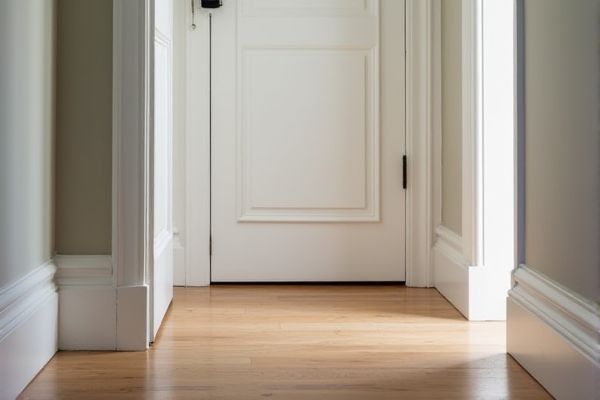
Open toe kicks create a visually seamless transition between cabinetry and flooring, enhancing the kitchen's modern aesthetic, while recessed toe kicks offer ergonomic comfort by providing extra foot space for easier access to countertops. Discover how choosing between an open toe kick and a recessed toe kick can impact both the functionality and style of Your kitchen by reading the rest of the article.
Table of Comparison
| Feature | Open Toe Kick | Recessed Toe Kick |
|---|---|---|
| Design | Exposed toe space at cabinet base | Indented toe space beneath cabinet base |
| Functionality | Allows foot placement for ergonomic standing | Provides hidden foot space, preventing contact |
| Aesthetic | Modern, open look | Clean, seamless cabinet appearance |
| Cleaning | Easier access for cleaning under cabinets | Requires more effort due to recessed space |
| Installation | Simpler and cost-effective | More complex, potentially higher cost |
| Durability | Less protected against damage | More durable base protection |
Introduction to Toe Kicks in Cabinetry
Toe kicks in cabinetry serve as recessed spaces at the base of cabinets, allowing users to stand closer without stubbing toes. Open toe kicks feature a visible gap, offering modern aesthetics and easy cleaning access, while recessed toe kicks are integrated spaces that provide ergonomic comfort and prevent foot injury. Both designs enhance kitchen functionality by improving posture and accessibility during extended countertop use.
What is an Open Toe Kick?
An Open Toe Kick is a type of cabinet base that features a recessed area at the bottom front, allowing more foot space for comfort while standing close to countertops. This design enhances accessibility by providing room for toes and feet, preventing awkward postures during kitchen tasks. Unlike a completely recessed toe kick, the Open Toe Kick maintains some structure but offers improved ergonomics in kitchen cabinetry.
What is a Recessed Toe Kick?
A recessed toe kick is a built-in countertop design feature where the front edge of the cabinetry is set back from the base, allowing your toes to fit comfortably underneath while standing close to the counter. This design improves ergonomics by reducing strain on your lower back during tasks like cooking or cleaning. Compared to an open toe kick, a recessed toe kick provides better foot clearance and enhances overall kitchen functionality.
Design Aesthetics: Open vs Recessed Toe Kick
Open toe kicks create a noticeable visual break with exposed gaps underneath cabinetry, emphasizing a modern, minimalist aesthetic that adds depth and lightness to the kitchen design. Recessed toe kicks, integrated seamlessly beneath cabinets, offer a sleek, continuous surface that blends smoothly with baseboards, contributing to a streamlined and cohesive look. Choosing between open and recessed toe kicks impacts both shadow play and spatial perception, influencing the overall balance and style of kitchen interiors.
Ergonomics and Comfort Considerations
Open toe kicks provide enhanced legroom and allow for closer positioning to countertops, reducing strain on the lower back and promoting ergonomic posture during prolonged kitchen tasks. Recessed toe kicks, while offering a sleeker appearance, may limit foot space and cause users to lean forward awkwardly, potentially leading to discomfort or fatigue over time. Selecting open toe kicks improves overall comfort by facilitating natural stance and movement, critical for maintaining ergonomic standards in kitchen design.
Cleaning and Maintenance Differences
Open toe kicks provide easier access for cleaning, allowing you to quickly sweep or vacuum debris without obstruction. Recessed toe kicks tend to accumulate dust and grime in the hidden crevices, requiring more detailed and frequent maintenance with specialized tools or brushes. Your choice affects the time and effort needed to keep kitchen floors spotless and hygienic.
Space Efficiency and Accessibility
Open toe kicks maximize space efficiency by allowing more room for foot placement, which is ideal for smaller kitchens with limited floor space. Recessed toe kicks enhance accessibility by providing a comfortable space for your feet, reducing strain during prolonged standing and allowing easier use of under-cabinet storage. Your choice between open and recessed toe kicks should balance the available space and ergonomic comfort needs.
Cost Comparison: Open Toe Kick vs Recessed Toe Kick
Open toe kicks typically cost less than recessed toe kicks due to simpler design and easier installation, reducing labor expenses. Recessed toe kicks, involving precise cuts and additional materials, drive up both material and labor costs. Homeowners often choose open toe kicks to stay within budget while recessed toe kicks offer enhanced aesthetic appeal despite higher expenses.
Best Applications for Each Toe Kick Type
Open toe kicks are ideal for contemporary kitchens and spaces that prioritize easy cleaning and accessibility, allowing You to reach under cabinets without obstruction. Recessed toe kicks suit traditional or minimalist designs by providing a subtle shadow line that visually separates base cabinets from the floor, enhancing aesthetic appeal and preventing scuff marks. Each type optimizes functionality and style based on kitchen layout and user preferences.
Choosing the Right Toe Kick for Your Project
Selecting the right toe kick for your project depends on your design goals and space requirements. An open toe kick offers easy access for cleaning and often creates a modern, airy look, while a recessed toe kick provides enhanced foot space and a traditional, streamlined appearance. Evaluate the functionality and style preferences to ensure your project benefits from the optimal blend of comfort and aesthetics.
 homyna.com
homyna.com